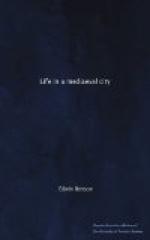The present streets called Shambles, Pavement, Petergate and Stonegate, contain excellent examples of mediaeval domestic architecture.
Shops were distinguished by having the front of the ground floor arranged as a show-room, warehouse, or business room which was open to the street. The trader lived at his shop. In the case of a butcher’s, for example, the front part of the shutters that covered the unglazed window at night, was let down in business hours so that it hung over the footway. On it were exhibited the joints of meat. Butchers’ slaughter-houses were then, as now, private premises and right in the heart of the city.
The rooms in the houses were quite small, with low ceilings. The small windows, whether they were merely fitted with wooden shutters or glazed with many small panes kept together with strips of lead, lighted the rooms but poorly. The closeness of the houses made internal lighting still less effective. The interior walls were of timbering and plaster, often white- or colour-washed.[5] Panelling was used occasionally. The ventilation and hygienic conditions generally were far from good, as may be imagined from a consideration of the smallness of the houses, the compactness of the city, particularly the parts occupied by the people, and especially of the primitive system of sanitation, which was content to use the front street as a main sewer. There were, of course, no drains; at most there was a gutter along the middle of a street, or at each side of the roadway. It was the traditional practice to dump house and workshop refuse into the streets. Some of it was carried along by rainwater, but generally it remained: in any case it was




